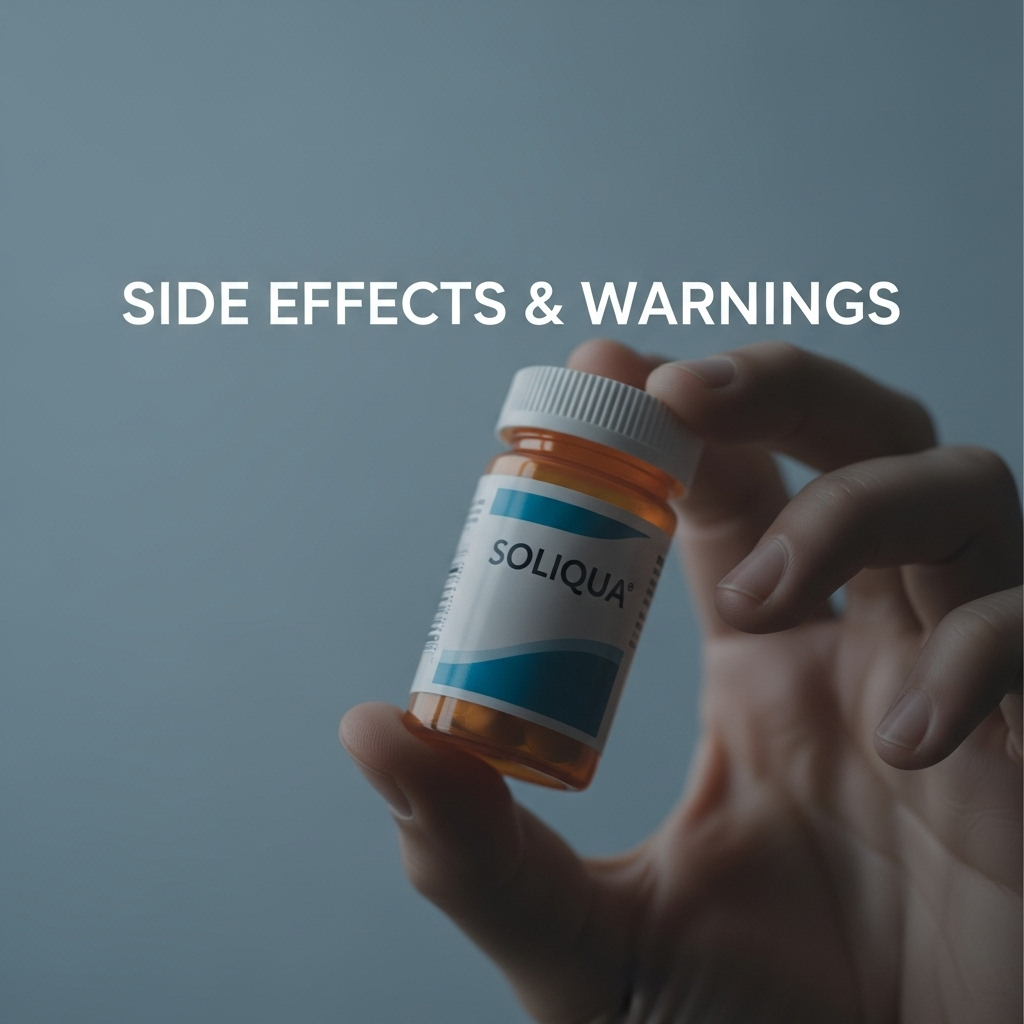Soliqua, a fixed-ratio combination of insulin glargine and lixisenatide, offers a modern treatment option for adults with type 2 diabetes who require additional glycemic control. While its dual-action formula provides both basal insulin coverage and post-meal glucose regulation, it is important to understand the full profile of Soliqua side effects, potential risks, and insulin safety guidelines. This article presents a thorough overview of known adverse reactions, precautions, and clinical safety insights.
Common Soliqua Side Effects: What to Expect
Most patients tolerate Soliqua well, especially when properly titrated. However, some side effects are relatively common and may appear during the initiation phase or after dosage adjustments.

1. Gastrointestinal Reactions
Due to the GLP-1 component (lixisenatide), GI symptoms are among the most reported issues.
-
Nausea
-
Vomiting
-
Diarrhea
-
Constipation
-
Abdominal discomfort
These effects tend to be dose-dependent and may improve over time as the body adjusts.
2. Hypoglycemia
When combined with other antidiabetic agents (particularly sulfonylureas), Soliqua may cause low blood sugar, especially if meals are skipped.
-
Symptoms include sweating, shakiness, dizziness, confusion, and irritability
-
Severe hypoglycemia may result in seizures or unconsciousness if untreated
Proper dosing and regular glucose monitoring reduce the risk.
3. Injection Site Reactions
Mild redness, swelling, or itchiness at the injection site may occur.
-
Rotate injection sites regularly to minimize irritation
-
Severe reactions are rare but possible with repeated use
4. Headache and Dizziness
Some users report mild headaches or lightheadedness, typically linked to early treatment stages or abrupt glucose level shifts.
Serious Soliqua Risks and Warnings
While rare, certain side effects require immediate medical attention. Understanding these Soliqua risks is vital for ensuring long-term treatment safety.
1. Pancreatitis
GLP-1 receptor agonists like lixisenatide have been associated with acute pancreatitis in post-marketing reports.
-
Symptoms include persistent upper abdominal pain, radiating to the back, often accompanied by vomiting
-
Discontinue use immediately if pancreatitis is suspected
2. Kidney Impairment
Gastrointestinal losses from nausea or vomiting can lead to dehydration, which may worsen or trigger acute kidney injury, especially in those with pre-existing renal dysfunction.
-
Monitor renal function in high-risk patients
-
Ensure adequate fluid intake
3. Allergic Reactions
Although rare, anaphylactic responses, angioedema, and generalized urticaria have been reported.
-
Immediate discontinuation and emergency care are required for hypersensitivity reactions
4. Thyroid Tumors
GLP-1 agonists have demonstrated a potential risk for thyroid C-cell tumors in rodent studies, though this has not been confirmed in humans.
-
Soliqua is contraindicated in patients with medullary thyroid carcinoma or a family history of this cancer
Long-Term Safety of Soliqua: Clinical Observations
Long-term studies of Soliqua (and its individual components) reveal a generally favorable safety profile, provided the medication is used as prescribed and side effects are managed proactively.
Clinical Data Highlights:
-
Combined therapy reduces HbA1c levels more effectively than basal insulin alone
-
Incidence of GI side effects is lower than with standalone GLP-1 agonists
-
Hypoglycemia risk remains low when not combined with sulfonylureas
-
No significant cardiovascular events reported in controlled studies
However, individual tolerance varies, and ongoing monitoring is essential.
Safety in Special Populations
Certain groups may be more vulnerable to Soliqua’s adverse effects. Extra precautions are advised.
| Population | Considerations |
|---|---|
| Elderly (65+) | May have reduced renal function; monitor kidney markers regularly |
| Pregnant or Nursing Women | Soliqua has not been studied in pregnancy; use only if benefits outweigh risks |
| Hepatic Impairment | Caution due to limited data on liver metabolism of lixisenatide |
| Gastrointestinal Disorders | Avoid in patients with gastroparesis or other severe GI conditions |
Safe Use Guidelines to Minimize Side Effects
To maintain insulin safety and reduce Soliqua-related risks, adhere to the following best practices:
-
Start with the correct dose based on prior insulin use
-
Administer at the same time daily, preferably before breakfast
-
Monitor blood glucose levels regularly, especially after dose changes
-
Avoid combining with sulfonylureas unless supervised by a provider
-
Stay hydrated to prevent kidney issues related to dehydration
-
Report persistent GI symptoms or unusual discomfort to a healthcare provider
-
Rotate injection sites to avoid local skin reactions
When to Contact a Healthcare Professional
Prompt medical attention is necessary if the following symptoms occur:
-
Severe abdominal pain or persistent nausea
-
Rash, swelling of the face/throat, or breathing difficulty
-
Confusion or unconsciousness from suspected hypoglycemia
-
Signs of kidney trouble (e.g., reduced urination, swelling, fatigue)
Do not discontinue Soliqua without consulting your physician, as abrupt changes can destabilize blood sugar levels.
Balancing Benefits and Risks of Soliqua
Soliqua’s unique blend of insulin glargine and lixisenatide brings an effective approach to managing type 2 diabetes, especially in patients needing tighter glucose control. While it offers convenience and improved outcomes, its use requires awareness of side effects, ongoing clinical monitoring, and careful adherence to insulin safety protocols.
By identifying early symptoms, maintaining regular follow-ups, and using Soliqua under proper medical supervision, patients can confidently manage their diabetes while minimizing potential complications.




